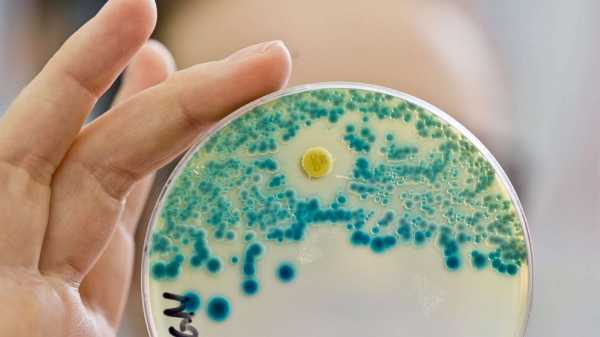
The centers for control and disease prevention reported on Tuesday the first results of their focused campaign with the aim of identifying infection “nightmare bacteria” – any one of several germs that cause infections that are almost impossible to cure with currently available medicines. These microbes defeated all current forms of antibiotics, leaving doctors and hospitals almost helpless to fight off infections.
Laboratories in 50 States and Puerto Rico 5,776 checked some samples of high microbial resistance to unusual patterns of resistance. One in every four samples of bacteria were found not only to have some antibiotic resistance, but carry the gene, able to spread that resistance. What surprised investigators most was that 221 of them had resistance genes described as “very rare”. In the next step, CDC officials and local health workers were looking for “colonization” – they checked the people in the immediate vicinity of an infected person (people who do not have the infection themselves) to see if they were harboring bacteria. Those who nourish of infection-causing organism, not the infection itself, called “carriers”. 10 people tested were carriers of resistant bacteria, and many different types were discovered.
Joe raedle/Getty images, FILEA pharmacy Manager counts out the desired number of antibiotic pills to fill a prescription August. 7, 2007 in Miami.
It was the first nationwide test of this magnitude, the search of resistant bacteria and their genes. It was only the first part of the initiative directed the FTC to consider this gradually disturbing health problems.
What you should know about resistant bacteria?
There are many classes of germs or microscopic organisms into the environment: bacteria, viruses, fungi, and parasites. Within these groups, many organisms do not cause any problems (or maybe even useful) for humans. The germs that cause the disease sometimes referred to as “activators” or simply as “germs”.
The development of antibiotics to treat pathogenic bacteria has become a real breakthrough in medicine. We treat infections with antibiotics for more than 70 years, and common infections that used to kill now trivial, because the antibiotics are fighting the same bacteria. The use of antibiotics, decade after decade, though, can make them less effective in the long term.
One of the reasons there are so many antibiotics that some have always been more effective against certain types of bacteria. You can think about them as well as you think, many different specialized weapons of war for different types of combat.
The problem is that some antibiotics that used to work against certain types of bacteria no longer work in certain strains of this species. And this list is growing. This is because bacteria can learn to put protection from the antibiotic. It appears when bacteria are exposed to antibiotics have seen – or even one similar to it. Bacteria, in fact, have been slightly modified and can now avoid the attack of the antibiotic. These “system resistance” can be incredibly diverse, complex, and even can be described as creative. When the bacteria “resist” the drug, the fetus is not killed, as supposed, the infection is not treated if an antibiotic can kill other less important bacteria, giving the resistant bacteria will to the growth and further spread.
CDCGRAPHIC: figure from the CDC shows how antibiotic resistance occurs.
Medical laboratories can test samples of bacteria from the patient to determine which antibiotics the bacteria will probably be – or will not – respond. This is called a “plan of resistance”. When the lab discovers that the germ is resistant to an entire class of antibiotics that are usually a good match for the body, it is called “unusual resistance pattern” and can mean bad news, the potential for this bacteria are becoming resistant to All or nearly all the antibiotics in existence.
Some microbes get nicknames based on major antibiotics they are resistant to: MRSA stands for “methicillin-resistant Staphylococcus aureus” (this strain has acquired resistance to methicillin, which is a stand-in for all drugs in the penicillin family). CRE stands for “Carbapenem-resistant enterococci”, indicating resistance to one of the more powerful classes of available antibiotics.
Bacteria resistant to multiple classes of powerful antibiotics of “multiple drug resistant”. As Dr. Anne Schuchat, Director of the Deputy Director of the CDC, describes these microbes cause “drug-resistant infections that are almost untreatable in modern medicine”. Some individuals are more likely to get these infections: people who live in nursing homes and other long term care facilities or those who are frequently admitted to the hospital are at high risk because they live in an environment where many people with infections are close together and germs can be easily separated. They also tend to have a weaker immune system to fight infections when they occur. Young adults with cystic fibrosis is another risk. They have a lot of respiratory infections in their lives that require a lot of courses of antibiotics – and many become carriers of highly-resistant bacteria as a result.
Resistant bacteria sometimes can be treated with more powerful or less frequently used antibiotics which can be more toxic effects and be extremely costly to the healthcare system. Sometimes only treatment options that doctors call “maintenance therapy”, which includes measures such as oxygen, medication to maintain blood pressure, and even ventilator or dialysis machines to support the failing bodies, hoping that the immune system will find a way to fight the infection. Despite these measures, up to 50% of nightmare cases bacteria can lead to death.
If that isn’t bad enough, scientists have also learned that germs are doing the equivalent of a crowdsourcing one bacteria develops resistance to antibiotics can “share” information for the defense system, Packed in DNA that can be transferred from one cell to another. The resistance genes or pieces of DNA, turning ordinary microbes into a nightmare bacteria. These genes are the focus of the current activities of the CDC.
What can be done to stop the spread?
The effects of antibiotics (“study the enemy”) is how bacteria develop their tools of resistance. For this reason, doctors know that antibiotics should only be used when they are needed and antibiotics (which specifically treat germs in the classification of bacteria) should not be used in an attempt to treat infections caused by other microbes-like viruses. For example, almost all “common cold” infection and viruses, but patients want to be given something, and often insist on antibiotics, even though he has no chance to affect the virus. As Dr. Jay Butler described, providers strive to use antibiotics in the “right situations with the right drug in the right dose for the appropriate period of time”.
According to the CDC, up to 50% of antibiotic violates one of these principles.
Another way that antibiotic resistance has spread through the widespread use of antibiotics to grow animals to accelerate animal growth. On the CDC website, “antibiotics…should be used in food animals grown only under veterinary oversight and only to manage and treat infectious diseases, not to promote growth.”
What is the CDC doing?
In 2016, the CDC launched a landmark initiative of the decision of antibiotic resistance, devoting more resources than ever before to prevent the spread of resistant bacteria. The two main features of this initiative are operational detection of unusual resistance patterns among infection-causing bacteria, and standardized infection control measures in the relevant medical institutions, including establishment of the persons colonized with the same germ and the strengthening of measures to prevent the spread of the most dangerous organisms.
Prevention of infections and bacteria is not a new concept. What is new, however, is a resource available to physicians and other healthcare professionals to do this. Labs have more opportunities for testing for the presence of microbes that carry resistance, and quickly get those results. Dr. Schuchat said that CDC is now “the promotion of health and health authorities to respond to isolated cases of emergence of antibiotic-resistant pathogens”. The analogy used in the FTC is the fire. In the past, public health authorities must use their resources to fight fires – the most stable and the most common nightmare bacteria that’s already out of control. This, of course, allowed for the development of even more resistant bacteria. With increased funding, the government can respond to the many smaller “fires” and even “sparks” to prevent further spread.
In addition to additional funding, the CDC is sending more than 500 local employees of partner companies across the country, when there are unusual patterns of resistance. They described a recent example, when the elderly in Iowa had a urinary tract infection. The CDC laboratory network of antibiotic resistance was performed rapid testing, which showed unusual resistance. The Department of health of Iowa has worked with the nursing home to do a site assessment and determine how the germ could spread. They checked the other residents in this facility for colonization and found that 5 of the others were carrying dangerous error. They implemented aggressive measures to combat infection and continued screening of patients until then, until the error was discovered.
DPA via AP images, FILEA laboratory keeps a bacterial culture that is used to determine drug resistance in the laboratory in Erlangen, Germany, July 21, 2015.
Obviously this is a very time – and resource-consuming, which explains why this approach is best used for microbes that are potentially very dangerous. As a guide the FTC has noted, however, it is more efficient (and less costly) if the tools are there immediately after a single case of discovery, instead of waiting for the epidemic. In Dr. Schuchat, “these unusual threats to rare or highly resistant microbes which have not yet spread throughout the U.S. We work to be ahead of them before they become prevalent in order to protect patients now and in the future.”
Dr. Jay Butler, Chief physician and Director of the Alaska Division of public health and the Association of state and territorial health authorities (also known as ASTHO), put it another way: “we can’t wait until one event will be in ten or ten cases will be one hundred. We could intervene early and aggressively to stop the spread and keep these threats to our States.” He added: “I have heard from my state and local colleagues from across the country to these resources was a watershed moment in their States.”
Work is just beginning. For every choking-resistant bacteria, the other increases its own resistance. “We must do more and we must do it faster and sooner with each new threat of antibiotic resistance,” Dr. Schuchat said. Medical facilities and and officials of the public health now more than ever to do this.
Dr. Kelly ARPS is a resident physician in internal medicine at the Johns Hopkins hospital. Kelly works with the news medical unit, ABC.
Sourse: abcnews.go.com






